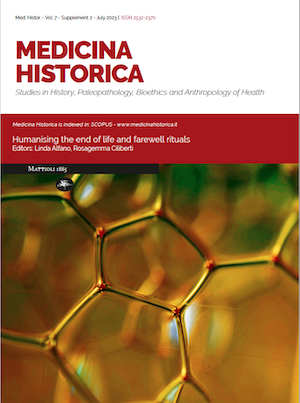Bereavement in the Digital Age: The Challenges of Online Sharing and Digital Memory Preservation
Keywords:
Selfies, funeral, social media, death, ritual, mourning, technology, funerary rituals, bereavementAbstract
The advent of digital networks and social networks has significantly affected, not only social behavior and daily life, but also the traditional ways of managing pain, mourning, and commemoration of the deceased. If, in the (recent) past, the presence of the deceased was limited to the memories of people who had known him, or to private photographic images that crystallized his moments of life, in the current technological context the deceased, from being "absent", remains subject "present" in the online spaces that people use every day.
Death, pain, and mourning are aspects of fundamental importance for human existence and today, thanks to the development of virtual environments accessible to all, death is brought back into the daily life of individuals. At the same time, digital technologies have given rise to new ways of expressing grief and expressing grief that transcend the traditional notions of mourning "of letting go", to continue their journey, soliciting multiple emotionally and culturally complex questions, involving different disciplines: morality, religion, philosophy, law, and sociology.
The authors intend to make some reflections on the most important digital transformations underway concerning the end of life, immortality, the elaboration of mourning and memory, and which seem to outline on the horizon a new idea of approaching and understanding death, rethought and adapted for the digital age.
References
EarthWeb: Twitch Statistics 2023: How Many People Use Twitch? https://earthweb.com/twitch-statistics/
Ford C, Gardner D, Horgan LE, et al. Chat speed op pogchamp: Practices of coherence in massive twitch chat. Proceedings of the 2017 CHI conference extended abstracts on human factors in computing System 2017; 858–71.
Harness J, Getzen H. TikTok's Sick-Role Subculture and What to Do About It. J Am Acad Child Adolesc Psychiatry 2022; 61(3):351–3.
Snodgrass JG, Lacy MG, Dengah FHJ, Eisenhauer S, Batchelder G, Cookson RJ. A vacation from your mind: Problematic online gaming is a stress response. Comput Hum Behav 2014; 38: 248–60.
Hilvert-Bruce Z, Neill JT, Sjöblom, Hamari J. Motivazioni sociali del coinvolgimento degli spettatori in live streaming su Twitch. Comput Hum Behav 2018; 84, 58–67.
Bailey T, Walter T. Funerals against death. Mortality 2016; 21:149–66.
Fiorese G. La condivisione del lutto online: lo scarto tra realtà e ostentazione. Dada Rivista di Antropologia post-globale 2019; 2:139–42.
Cotroneo R. Lo sguardo rovesciato. Milano: Utet; 2015.
Brubaker JR, Hayes G, Dourish P. Beyond the Grave: Facebook as a Site for the Expansion of Death and Mourning. Inf Soc 2013; 29(3):152–63.
Zhao S, Zappavigna M. Beyond the self: Intersubjectivity and the social semiotic interpretation of the selfie. New Media Soc 2018; 20(5): 1735–54.
Gibbs M, Carter M, Nansen B, TamaraK. Selfies at Funerals: Remediating rituals of mourning. 2014. https://www.researchgate.net/publication/263567059_Selfies_at_Funerals_Remediating_rituals_of_mourning
Du Preez A. Sublime selfies: To witness death. Eur J Cult Stud 2018; 21(6):744–60.
Richardson I, Wilken R. Parerga of the third screen: Mobile media, place and presence. New York: Routledge; 2012:181–97.
Van Dijck J. Digital photography: communication, identity, memory. Visual Communication 2008; 7(1):57–76.
Tajfel H, Turner JC. The Social Identity Theory of Intergroup Behavior. (Edit by) John T. Jost, Jim Sidanius. Political psychology: Key readings. New York: Taylor & Francis; 2004:276–93.
Goffman E. The Presentation of Self in Everyday Life. New York: Doubleday Anchor Books; 1959.
Goffman E. Interaction Ritual: Essays on Face-to-face Behavior. New York: Pantheon Books; 1967.
Arnold M, Gibbs M, Kohn T, Meese J, Nansen B. Digital Death. Boca Raton: Routledge; 2017.
Sofka CJ, Gilbert KR, Cupit, IN. (Edit by). Dying, death, and grief in an online universe: For counselors and educators. Berlin: Springer; 2012.
Meese J, Gibbs M, Carter M, Arnold M, Nansen B, Kohn T. Selfies at Funerals: Mourning and Presencing on Social Media Platforms. Int J Commun 2015; 9(14):1818–31.
Moreman CM, Lewis AD. Digital death: mortality and beyond in the online age. London: Bloomsbury; 2014.
Sisto D. 2017. Digital Death. Una morte postumana? Lo Sguardo 2017; 24:157–76.
Ziccardi G. La “morte digitale”, le nuove forme di commemorazione del lutto online e il ripensamento delle idee di morte e d’immortalità. Stato, Chiese e pluralismo confessionale 2017; 19. www.statoechiese.it.
Licata M, Larentis O, Tesi C, Fusco R, Ciliberti R. Tourism in the Time of Coronavirus. Fruition of the “Minor Heritage” through the Development of Bioarchaeological Sites. A Proposal. Heritage 2021; 4:759–74.
Murphy M, Templin J. ReplikaAI: This app is trying to replicate you. 2019; https://qz.com/1698337/replika-this-app-is-trying-to-replicate-you
Amendola A, Grillo M. Immagini e riproducibilità del sé nella digital society: pratiche e strumenti digitali per la costruzione dell’identità. Eco 2021; 3. https://ojs.cimedoc.uniba.it/index.php/eco/article/view/1304.
Rodotà S. Il mondo nella rete. Quali i diritti, quali i vincoli. Roma-Bari: Laterza; 2014:43–44.
Aries P. Storia della morte in occidente. Segrate: Rizzoli; 1998.
Gozzano G. I colloqui. Milano: Fratelli Treves; 1911.
Bodei R. Limite. Bologna: il Mulino; 2016:25–6.
Downloads
Published
Issue
Section
License
This is an Open Access article distributed under the terms of the Creative Commons Attribution License (https://creativecommons.org/licenses/by-nc/4.0) which permits unrestricted use, distribution, and reproduction in any medium, provided the original work is properly cited.
Transfer of Copyright and Permission to Reproduce Parts of Published Papers.
Authors retain the copyright for their published work. No formal permission will be required to reproduce parts (tables or illustrations) of published papers, provided the source is quoted appropriately and reproduction has no commercial intent. Reproductions with commercial intent will require written permission and payment of royalties.

This work is licensed under a Creative Commons Attribution-NonCommercial 4.0 International License.

